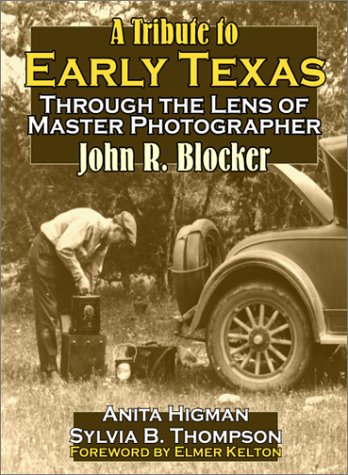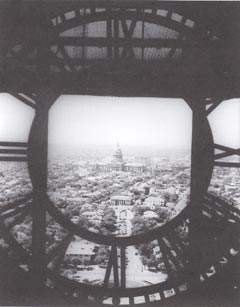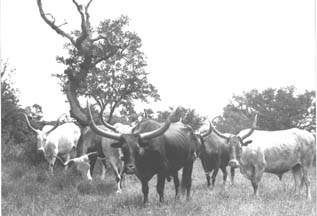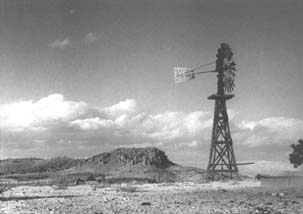A Tribute to Early Texas
Through the Lens of Master Photographer John R. Blocker
Book Review by Steve Labinski
 John Blocker was a regular guy, whose hobby was photography.
What makes his work interesting is the man's outstanding eye for remarkable features
found in the Texas landscape of the 1920's, 30's and 40's. Raised in the central Texas
Hill Country area, Blocker loved everything Texan - the longhorns, the creeks and hills,
the West Texas countryside. A Tribute to Early Texas collects John Blocker's interesting
oeuvre of work into an oversized paperback full of photographs, historical
backgrounds and poetic prose about the state.
John Blocker was a regular guy, whose hobby was photography.
What makes his work interesting is the man's outstanding eye for remarkable features
found in the Texas landscape of the 1920's, 30's and 40's. Raised in the central Texas
Hill Country area, Blocker loved everything Texan - the longhorns, the creeks and hills,
the West Texas countryside. A Tribute to Early Texas collects John Blocker's interesting
oeuvre of work into an oversized paperback full of photographs, historical
backgrounds and poetic prose about the state.
Blocker was born in 1878 to a cattle family. He ranched for a little while, but wound up
working at the University of Texas for thirty years. His hand at mechanics easily transferred
into his aggressive and large amount of photographic work. In the 1920's, cameras were not
small, precision instruments with a wide variety of easily replaceable attachments.
At the time, being a photographer required mechanical know-how and strength.
The
book's forward gives an interesting explanation of Blocker's favorite apparartus
- the view camera.
The view camera was very high quality, but extremely bulky requiring many additional
attachments. The film slides rested in glass plates, which stayed out of the
light.
Traveling to places like Enchanted Rock or Big Bend during that time was very time
consuming. The road highway system was primitive. Traveling to many venues required
extensive off-road travel, carrying heavy equipment. Blocker clearly embraced photography
with passion and drive.
Blocker also spent hours waiting for that perfect moment where the sunlight hits the scenery in exactly the correct way.
 This appears in his many photographs of the Big Bend countryside, to which an entire chapter is devoted in the book. Many of his photographs are inventive, giving us insight to the mechanics of the man's imagination. One of Blocker's more famous photos is of the University of Texas clock tower. The tower, built in the 1930's after oil was discovered on university land, is four-faced looking out over the city of Austin. We see the view of the Texas Capitol building and the original forty acres of the campus far below from the inside of the tower, before the clock mechanism was installed.
This appears in his many photographs of the Big Bend countryside, to which an entire chapter is devoted in the book. Many of his photographs are inventive, giving us insight to the mechanics of the man's imagination. One of Blocker's more famous photos is of the University of Texas clock tower. The tower, built in the 1930's after oil was discovered on university land, is four-faced looking out over the city of Austin. We see the view of the Texas Capitol building and the original forty acres of the campus far below from the inside of the tower, before the clock mechanism was installed.
Blocker also enjoyed taking photos of cattle, especially Texas longhorn. There are also other photos of animals like sheep and goats as well. There are numerous photos of old windmills and wide open plains - all trademarks of the distinctive Texas countryside. The book's subtitle, Through the Lens of Master Photographer, is a little lofty. I suspect Mr. Blocker himself would have cautioned about labeling him as a master photographer. However, his love for his work, and his surroundings, clearly shine brightly. He captures forever on film numerous scenes, monuments and old landmarks, many of which today are just a fading memory.
|


|
From The Book:
Enchanted Rock is the second largest batholith in the United States; only Georgia's Stone Mountain is more massive. It is some of the oldest exposed rock in North America. The sheer size of the ancient pink granite dome makes it the most spectacular natural landmark in the Hill Country, and it's the most famous feature of the Llano Uplift in Central Texas. It's fascinating to imagine that the part of the rock we can see is just one small exposed part of the batholith that covers more than 100 square miles. On the surface, we see about seventy acres of pink granite that reaches around 400 feet at the top of its rounded dome.
The term batholith means a gigantic mass of molten rock (magma) that intruded above the earth's surface and cooled beneath the earth's crust. Geologists think that initially the bump was 1,000 feet high and 70 miles across. When the rock cooled, it was the pink and gray granite you see today.
One interesting fact that amazed early visitors was the claim that you could not make a dent in its surface with a hammer or chisel. One early writer claimed it was entirely made of metal, probably platinum. It appears so smooth because erosion has shaped and rounded it endlessly. The scientific term for this action is called exfoliation. Thankfully, it still remains so unblemished for us today because the rock's granite is too coarse to be quarried for commercial building. From the top of the onion-shaped rock, you can see the Hill Country for miles and miles.

|
|
If you have a comment or review of this book, feel free to send it to
texana@texascooking.com
© 2002 Texas Cooking Online, Inc. -- ALL RIGHTS RESERVED